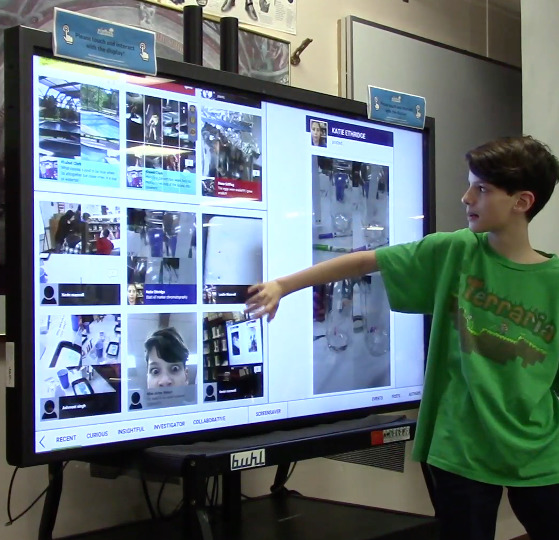
Teaching and learning is most effective and engaging when students have an authentic purpose for learning. By maximizing relevance and value, educators can help students make connections between academic content and what they see in the world around them. It’s one way to ensure that historically and systematically excluded learners have sustained and meaningful experiences of Powerful Learning, putting them on a path to postsecondary completion—one of Digital Promise’s North Star goals.
In a recent webinar hosted by Digital Promise titled “Leveraging the Village for Real World Community Science Learning,” Dr. Tammy Clegg, researcher and associate professor at the University of Maryland, shared her research on the impacts of community based science learning on perspectives of STEM. The audience of educators, school leaders, and curriculum developers engaged in roundtable discussions where they considered the possibilities for community science learning in their contexts. The presentation is available to view now.
Oftentimes when working with communities, especially communities that are marginalized and resource constrained, a deficit perspective dominates, with a focus on what the community lacks or what they need. Asset Based Community Development (ABCD) changes that narrative, guided by the foundational belief that everyone has gifts and strengths that can contribute to a healthy community. It’s a strategy for improving communities from the ground up.
Dr. Clegg applies the ABCD approach to the context of science learning. She explained that her research “recognized that all communities have really rich assets that can be leveraged to promote learning. How can we leverage these strengths or these assets and bring people together to really build capacity? I think about how we can do this to promote learning.”
In her Science Everywhere project, Dr. Clegg and her team of researchers set out to learn how children develop scientific dispositions by giving them mechanisms to capture and share the science they were using across the contexts of their lives. They provided after school programs, co-designed technologies with educators and the community to capture science learning, and worked with schools to integrate that technology into the classroom. They developed a socio-technical system with an online app and a digital community bulletin board where participants shared and discussed the science they saw around them.

Science Everywhere’s Digital Community Bulletin Board.
By using the ABCD approach, they found that not only the students learned science, but the adults involved—community partners, parents, and volunteers—also changed how they think about science. As a result, participants began enacting their own unique approaches to science and community engagement. For example, one participant, a local pastor, shifted from seeing science as “not in his lane” to working with students and the local watershed society to improve the water quality behind his church. The ABCD approach to science began shaping their identities and perspectives on the world, and ultimately led to broadened perspectives of STEM.
In breakout rooms, participants discussed how they can leverage Science Everywhere practices in their own communities. One participant reflected on the connections between Dr. Clegg’s work and Dr. Mimi Ito’s work on Connected Learning, which was presented in the previous webinar. Specifically, they noted how Dr. Clegg’s work reflects the key elements of relationships and opportunities in Connected Learning, and elaborates on the element of interest to include values and culture. Participants discussed how building relationships first is the key to community involvement, and how digital participation can be a strategy for removing barriers to engagement. They brainstormed ideas for how to tap into students’ interests, such as accessing local community mentors, visiting local workplaces and community events, and identifying current important topics in the community. For example, Bev Freedman, a Canadian education leader, shared how schools she’s working with are helping learners understand the connection between land, environment, and community, specifically as it relates to Canada’s indigenous populations.
Several participants shared what real world community learning looks like in their contexts. For example, participant Tim Dixon held a CODE.org night where students in grades kindergarten through grade 6 engaged in computer science activities alongside their parents. Michelle Gilbert used technology to take her online students based in Louisiana on a walk through a desert in her homebase of Arizona. Sonia Thomas worked with elementary school students to develop a community garden (now in its seventh year), partnering with parents, master gardeners, and other volunteers.
This webinar was an extension of Digital Promise’s work sponsored by the Wallace Foundation on principal leadership in a virtual environment (2021). This webinar was the fourth in a series, with the goals of continuing the conversation and further advancing school leaders’ understanding of current, critical topics and their application in their learning environments.
Next, on November 10, 2022 at 12 p.m. ET, we’ll continue to develop the theme of “asset-based learning” when we host “Culturally Relevant Teaching and Learning” with Dr. Thomas Philip. Sign up for the webinar on Eventbrite.
Want to know more about supporting connected learning experiences? Below are resources recommended by Dr. Tammy Clegg, as well as resources from Digital Promise:
Follow @DigitalPromise on Twitter to stay updated on upcoming research-to-practice webinars and events.